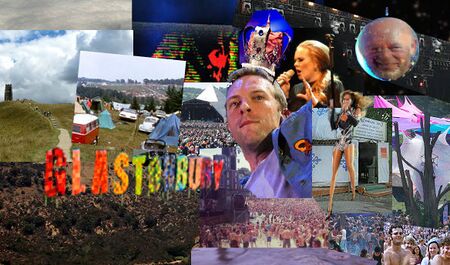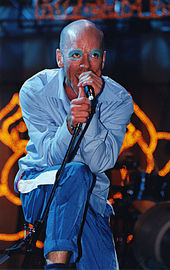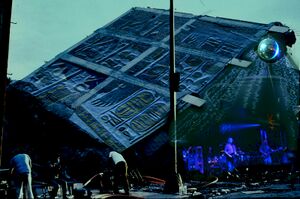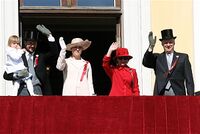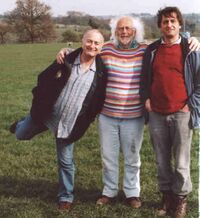Glastonbury Festival
Glastonbury Festival is a maximum-security live music penitentiary held every year on a farm near Glastonbury, Somerset, England during the summer season. The event has played host to some of the most legendary names in music on Earth including Rod Stewart, Beyonce and Basement Jaxx.
History[edit]
Hippie roots[edit]
The festival was founded in the 1970s by a local entrepreneurial dairy farmer, Michael Eavis, who discovered that hippies were partial to organic milk and yoghurt. At around this time the summer of love had become the autumn of inertia as the sixties rainbow-bubble burst and was transformed into a blood-thirsty, brown and orange seventies vampire bat. The rise in fashion of drugs such as cocaine had also turned the figureheads of the hippie movement, The Beatles and Bob Dylan, from preachy men with beards into preachy men with beards, law suits coming out of their arse, daily business meetings and sports cars.
Judasgate[edit]
An infamous incident at the end of the sixties, construed as the moment which "shattered the decade's ideals of peace and love" by former The Doors frontman Bono, happened at Bob Dylan's final ever appearance in Bradford. A crowd of broody Yorkshiremen heckled the folk-singer off stage with chants of "Judas" and "You bloody twat" after he started playing material from an unreleased album of songs about moving his money to a tax-haven and hiring out a private detective to dish up dirt on a local judge.
Jakob Dylan stated that his fathers's album was autobiographical and that everything in the lyrics "pretty much all happened", which the singer denied. At around the same time a public official had started a lawsuit against Dylan after the singer had bought up every property in a county in Minnesota and renamed the county The Dylan Ranch.
Sectarianism[edit]
After Judasgate, Dylan was written off for decades by critics and hippies alike. Now without a leader, the hippies were even more directionless and found themselves swimming in a very cold bath with flared trousers for fins. A rift which fragmented them indefinitely was caused by Marc Bolan, a potential new figurehead for the hippies. When he transformed his band from Tyrannosaurus Rex, a whimsical folk guitar and bongos act, into the glam rock of T. Rex overnight (after producer Tony Visconti accidently spilled tipex over a draft of the next album sleeve), the usually placid, long-haired dudes were in uproar. Radio DJ John Peel was so incensed by this that he broke his usually lugubrious demeanour and publicly lambasted Bolan, calling him a "bellend", while the uncharacteristically strung-out hippie movement was torn apart by sectarian violence.
A hippie now had two options: sell-out and become a player on the financial stock exchange of life and a Gary Glitter fan, or, leave civilised society behind to form their own community in the countryside. Those in England who chose the latter embarked on a journey across Salisbury Plain before settling on Glastonbury. Anthropologists studying tribal migration concluded that these nomadic hippies chose the location because of the village's history as a pilgrimage, the abundance of left-wing sympathisers working at the Job Centre and its proximity to Cheddar Gorge, where a free food source, cheese-ore, lay buried in the rock. This cheese-ore could be mined and extracted to make a delicious hippie cuisine: cheese on toast.
Throughout the eighties Margaret Thatcher shut down many of the mines across England and Slovakia despite peaceful protests from hippies. These closures forced the movement to purchase cheese from thee seeupermarket or to become vegan. Today, nearly every hippie practices veganism, except for the Dalai Llama of course (for health reasons).
Early lineups[edit]
While cashing in on the huge influx of hippies to Glastonbury during the organic milk boom, the cunning Eavis had the foresight to realise that with newly invented man-made products such as soya, rice and almond milk now available on the market, he would soon be up shit creek. He decided that he would hold an annual festival to generate publicity and even more money for his dairy products while the cow milk bubble lasted, featuring washed-up musicians who had stumbled into Glastonbury in search of cheap LSD.
Artists including Hawkwind, Fairport Convention, Gong, Henry Cow, Cilla Black and The James Last Orchestra were among the very first performers. Due to the readily available supply of psychedelic drugs, locally brewed Somerset cider and tie-dye t-shirts, the festival grew in popularity throughout the seventies and eighties, until it got so out of control that Eavis called a stop to it for several years so he could count his money and transport it off-site in a fleet of 50 armoured vans, loaned from Lemmy.
Security[edit]
The festival site is now one of the most high-security compounds in the world. It is notable for having a 50ft-high concrete perimeter fence designed by former Israeli border defence officials. On the extra security measures, Eavis admitted: "a lot of money was spent on that fence to ensure that Glastonbury is an establishment-friendly, celebrity-only party so we can make the coverage more entertaining and much more sellable to media and television outlets."
The perimeter is guarded by private military contractors out of work since the stabilisation of Basra following Live Iraq - a one-off fundraising event created by Bob Geldof, with performers including Coldplay and Queen featuring Patrick Kielty. Midge Ure is perceived by Middle East political experts as the uncredited mastermind behind one of the most remarkable peace settlements in the region's history - for managing to arrange a temporary ceasefire from Shia and Sunni extremists while the Stereophonics played.
The Pyramid Stage[edit]
The Pyramid Stage is the largest and oldest music stage in the world, built between 3000 BC to 2000 BC during the neolithic era. Its architects were the druids who also constructed nearby Stonehenge on Salisbury Plain. This ancient superstructure was succeeded by the Egyptian pyramids and 10 out of 10 of the top archaeologists in the world agree that druids migrated from Western Europe to the Old Kingdom in the latter part of the Stone Age following an EasyJet deal on flights. The druids brought to Egypt their skills in building ancient superstructures, a knowledge of mycology and a taste for space-rock.
British antiquarian and the world record holder for punching cattle, Julian Cope, has written several non-fiction books and albums on the subject: The Pharoahs Were On Mushrooms, Druids Built The Pyramids and Ancient British Monuments: From Salisbury to the Sphinx.
The Glastonbury Pound[edit]
Under its mirthful, muddy surface, Glastonbury has a strong anti-corporate message and even has its own currency, the Glastonbury Pound (G£). The G£ was invented by a team of Sir Paul McCartney's financial advisors while waiting for him to finish a talk on behalf of his animal rights organisation Cruelty To Wings.
Punters must exchange all of their cash and valuables into the G£ currency (made from cowpat) upon entering the festival at a specially made bureau-de-change located in a cattle shed. These cowpat coins can then be used to purchase drinks, Linda McCartney sausages (the only food allowed to be consumed on the site) and counterculture paraphernalia such as healing stones and lighters.
Charity Work[edit]
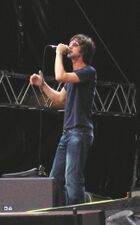
Sir Richard Ashcroft[edit]
During Glastonbury weekend, English composer and philanthropist Sir Richard Ashcroft has been known to hold off-site workshops for impoverished children at youth centres throughout neighbouring villages. These involve teaching the kids the chords for Bittersweet Symphony on guitar and waving £50 notes around as prizes to any child whose parent recognises him from the music video of the song.
In an interview with The Guardian he made his motives clear: "I want to ensure young people have the same opportunities I have had by teaching them Verve songs and giving them advice on how to make money by playing songs which somebody else wrote. I never made a penny off the royalties from it (Bittersweet Symphony) because the music was written by someone else but it still gets people singing along in the pub and on the underground. I can still fill my hat with it".
Glastonbury Space Program Foundation[edit]
The price of a ticket to the festival has risen by astronomical levels in recent years, with entry now worth a year's salary (or dole money) to a hippie or musician. Emily Eavis, daughter of Michael, defended the increases by claiming that they are necessary to support Glastonbury Space Program Foundation, which aims to be the first live music event in space.
Glamping[edit]
Glastonbury offers self-catering accommodation in the form of fully-furnished yurts, which give the illusion of roughing it but with the comfort and security of a log-cabin. These lavish, trendy, modern abodes for VIPs are favoured by younger, wealthier punters, such as the sons and daughters of respected establishment figures (including former Prime Ministers, Prince Charles, Keith Allen, The Rolling Stones and The Clash) who see bathing in, eating and fornicating in mud as something that the working classes do.
Media coverage[edit]
Glastonbury is broadcast internationally on television by the BBC, with celebrity guests each receiving an obligatory interview to waffle about themselves and their favourite acts in a pair of stunt-wellies, given to them to create the impression that they actually enjoy crowds of pissed-up people pointing and taking selfies with them while being up to their knees in excrement.
The festival is also known as a cocoon for DJs to metamorphose into remarkably likeable, witty and hilarious television presenters. Edith Bowman, Lauren Laverne, Mark Radcliffe and Zane Lowe (up until his untimely death in 2015 when he became the UK's most mourned celebrity since Princess Diana) are now as well known for their in-depth musical knowledge and chronic colds and runny noses (symptomatic of cocaine use) as they are for ad-libbing about their wellies, the weather, foreplay, and glamping, as well as their humorous fart jokes.
In 2014, Glastonbury Festival was voted top of the list in The Telegraph's Top Trendy Places to Visit If You've Got Loads of Money, and according to Foxtons director Doug H. Balls is one of the hottest places for buy-to-rent properties and holiday homes in the UK market.
